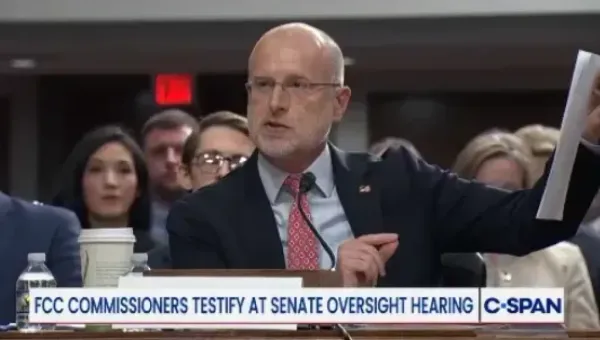Wolfgang Briglauer: For the FCC, a Cautionary Tale of EU 'Open Internet' Rules
Strong empirical evidence emerges that open internet regulations exert a significant, strong negative impact on fiber investments.
Wolfgang Briglauer

Outside of a short experiment in 2015-2017, U.S. broadband networks have been lightly regulated, and the successful results of this approach speak for themselves.
By comparison, the European Parliament promulgated strict, interventionist “open internet” controls on price and traffic in 2015, which have subsequently been toughened with prohibitions on the use of free data. Americans enjoy next generation network investment, deployment, and adoption at twice the rate of Europeans.
Analysis of comprehensive broadband data spanning 20 years in many OECD countries (including South Korea, Japan, Australia, and New Zealand which have never imposed hard “open internet” rules) supports the superiority of a light touch approach to drive connectivity.
To measure the causal impact of open internet regulation a group of European economists conducted an in-depth investigation on broadband investment using data on high-speed wireline networks (fiber-optic, cable-based). The research models the broadband market in a simplified two-sided market framework and performs a series of calculations and regressions. The data sets comprise the OECD figures for 32 countries from 2000 to 2021, covering the entire high-speed broadband network era and all major policy changes in the past.
Open internet regulations exert a significant negative impact on fiber investment
Strong empirical evidence emerges that open internet regulations exert a significant, strong negative impact on fiber investments which is also in line with the broader literature on the impact of access regulation on infrastructure investment. In contrast, there is still no empirical evidence to support the predictions of net neutrality advocates.
This finding raises also major concerns regarding next generation wireless network investment like 5G where business cases crucially depend on the possibility of quality differentiation such as network slicing. In fact, there is an observable correlation with countries that impose strict net neutrality regulations and a subsequent slowing of deployment of new fiber-based and 5G broadband suggesting that the EU is substantially lagging behind 5G network coverage in North America and China.
In practical terms for today, the annual US capital expenditure on broadband infrastructure, topping $100 billion annually, is more than twice that of the EU. 5G coverage in the EU is spotty, and less than one-third of Europeans have adopted it, whereas 60 percent of Americans have a 5G subscription according to Ericsson and GSMA. The OECD notes that the U.S. also has a slight edge in the penetration on total fixed line high speed broadband per 100 persons, even though it is significantly less densely populated compared to the EU.
Importantly, the U.S. had a natural experiment with such rules for 2-3 years. When they were removed, nothing bad happened; ISPs did not block or throttle end users or content providers. In fact, network performance improved as measured in speed, technology, throughput, competition, value for money, and closing of the digital divide.
In addition, open internet policies imposed on only one segment of the Internet value chain have become increasingly ineffective due to important technological developments, such as different types of (unregulated) private networks and content delivery networks, and EU-style net neutrality regulations will lead to significant market uncertainty and compliance grey zones due to related regulatory and technological complexity. The latter will further reduce incentives for investment and innovation in view of current (5G) and upcoming (6G) technologies.
EU policymakers have lamented the region’s low broadband investment and lack of next generation coverage. Interestingly, upon leaving the EU, the United Kingdom softened its open internet rules finding that while the policy clearly benefitted large software platforms and video streaming providers, it harmed consumers by driving out broadband network innovation and meaningful differentiation in customer offers.
The Biden Administration has laudable goals for ubiquitous, high-speed broadband and affordability. However, it is hard to see these goals achieved under a return to Title II reclassification of broadband, which unwittingly will make broadband deployment more slow and more expensive. This time, the FCC is poised to go a step further by not forbearing broadband providers from Section 214 provision (as the 2015 rules did).
Under the proposed interventionist regime, the FCC will demand an application from broadband providers to acquire, add, remove, or “discontinue” any broadband “line.” Notably this would reduce the speed at which providers could retire copper DSL lines and replace them with fiber as well as add new wireless or satellite broadband connections.
Heavy handed regulation has not improved broadband investment or rollout in the European Union, nor will it in the US. The FCC should take note before derailing its accomplishment.
Wolfgang Briglauer is Senior Researcher at Vienna University of Economics and Business, and Head of the Digitalization and Regulation Research Section at EcoAustria, Vienna. This Expert Opinion is exclusive to Broadband Breakfast.
Broadband Breakfast accepts commentary from informed observers of the broadband scene. Please send pieces to commentary@breakfast.media. The views expressed in Expert Opinion pieces do not necessarily reflect the views of Broadband Breakfast and Breakfast Media LLC.









Member discussion